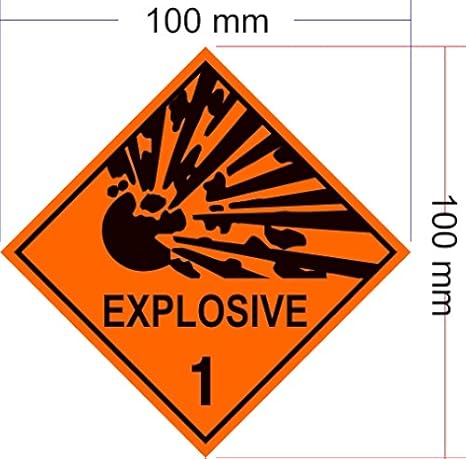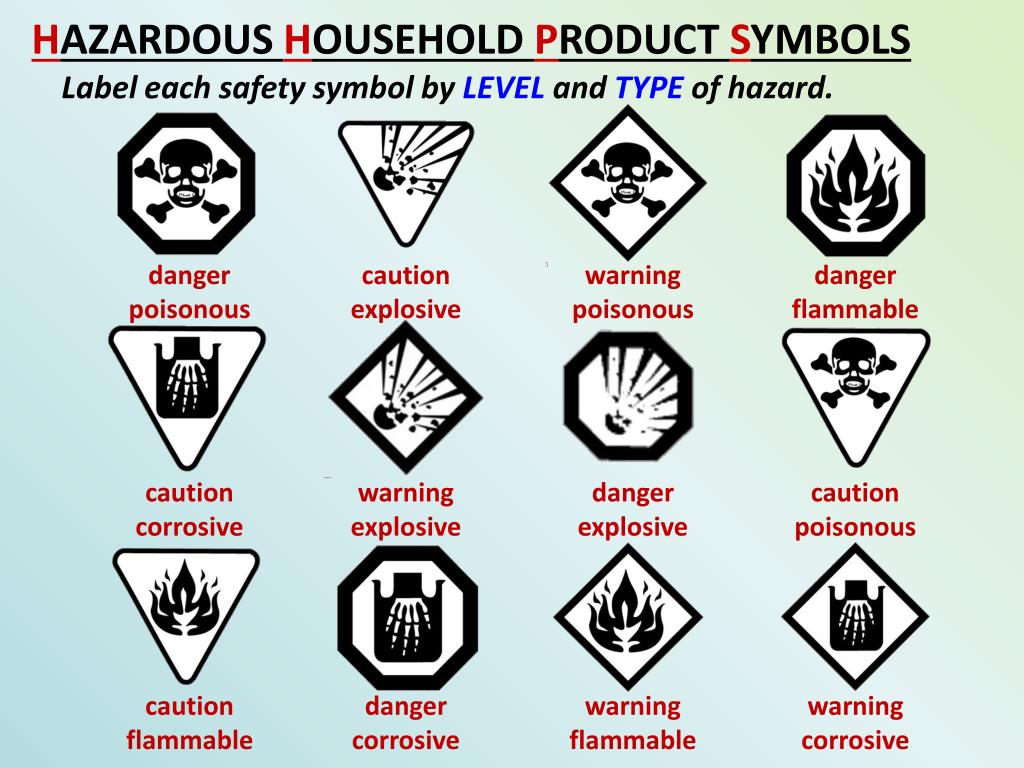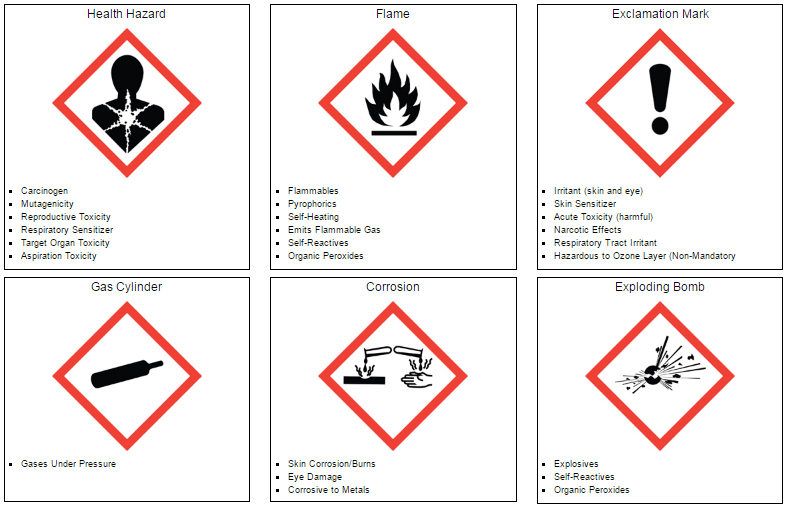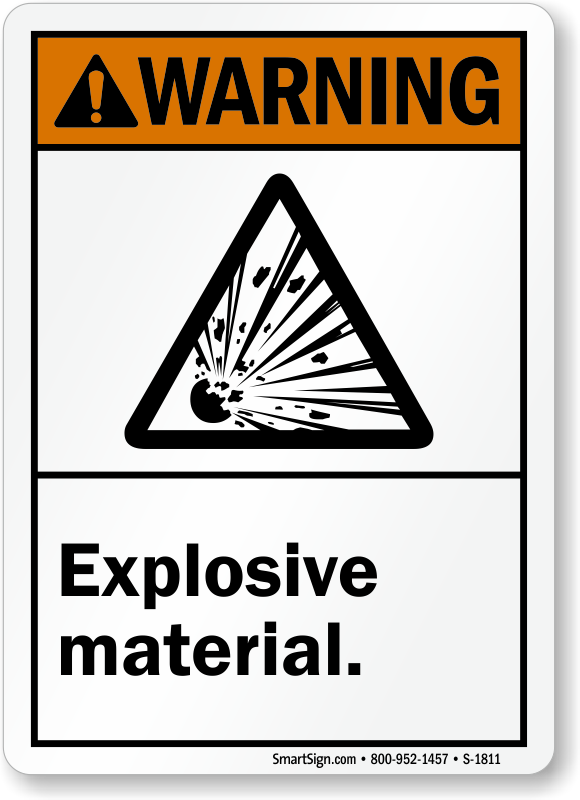40 explosive symbols are used to label materials
OSHA - MODULE 4: HEALTH HAZARDS: Hazard Communication - Quizlet Reacts with water to release a gas that is either flammable or presents a health hazard Colors on labels Voluntary -Blue indicates degree of hazard -Red indicates flammability -Yellow represents reactivity -White other/special/PPE THIS SET IS OFTEN IN FOLDERS WITH... OSHA 30 - Module 11: Welding, Cutting and Brazing 10 terms QuizMeNoMore GO 3. Identification, Classification and Labelling of Chemicals The UN RTDG label defines hazards by the use of symbols, colours and danger warning words for specific hazards (explosive, radioactive, corrosive, etc.). 1. Chemical identity ... Dangerous Properties of Industrial Materials, VII ed., Nostrand Reinhold Co., New York 1988 UNITED NATIONS, Transport of Dangerous Goods, 8th Ed., New York 1993 ...
Updated WHIMIS 2015 Symbols in Canada - Advanced Consulting and Training Skull & Crossbones (Can cause death or toxicity with short exposure to small amounts) This symbol has long been associated with death and it is used in materials labelling to warn you that the relevant product has potential to be fatal, toxic, or extremely harmful even with a limited exposure.

Explosive symbols are used to label materials
What does the explosive symbol mean? - FindAnyAnswer.com Exploding Bomb (Explosion or reactivity hazards) The symbol of an object exploding is used to clearly signify that the material is explosive and risks combusting when handled improperly. These materials should be handled only by professionals under safe conditions. What products have explosive symbols? Explosive Material Labels - MySafetyLabels.com Explosive Material Labels (26016) Explosives should be marked by proper warning labels to ensure thorough safety. Our wide selection of explosive material labels communicate the hazard associated with an explosive substance so that untrained personnel can stay out of harm's way. 10 Explosive Substances In Everyday Items - Listverse Nitrocellulose is classified as an explosive if the nitrogen content exceeds 12.6 percent. The compound has been used since the 19th century in paint, plastics, propellants, nail polish, fireworks, pharmaceuticals, explosives, coatings, Ping-Pong balls, smokeless gunpowder, flash paper, and more.
Explosive symbols are used to label materials. What Do the Different Hazardous & Safety Signs Mean? Flammable Solid, Spontaneously Combustible and Dangerous When Wet: Class 4 signs also include the flame symbol, but they include three different divisions. The red and white striped sign indicates a flammable solid. The half white, half red sign indicates that a material could spontaneously combust. Hazard Class 1 - Explosive Labels from Labelmaster Examples of explosives include ammunition, fireworks, flares, primers, ignitors and air bag inflators. Constructed of paper or rugged, flexible vinyl, these labels feature strong adhesion to painted, steel, fiber and plastic surfaces. They also meet the design and durability standards of 49 CFR, ICAO and other international air regulations. Class 1 - Explosives - Placards and Labels according 49 CFR 173.2 ... Labels In addition to complying with 49 CFR §172.407, the background color on the EXPLOSIVE 1.1, EXPLOSIVE 1.2 and EXPLOSIVE 1.3 labels must be orange. The "**" must be replaced with the appropriate division number and compatibility group letter. Chemical - Explosives Signs and Labels - ComplianceSigns.com Explosives Explosive Signs and Labels Protect your business, employees and customers with safety signs and adhesive labels that inform them of the presence of explosive substances in or near your workplace. Identify where a blast might occur and where substances that might cause them are stored or used.
Explosives Signs, Explosion Hazard Signs - Safety Sign Warn workers and visitors of Explosion Hazards in your facility with Explosives Signs from SafetySign.com. Keep them safe and purchase your signs today. ... Explosive Material Warning Label. ISO W002. Item J6538. Navigation. Search. 800−274−6271. Email. ... International Safety Symbols; Machine Safety Labels; Personal Protection Labels ... Health and safety: Hazard symbols - SAMANCTA Hazard symbols. Three systems of hazard markings and classification are currently in use. The most common is the ADR (see below). You may also see GHS symbols ( link ). The third set ( link) are now out of date but may still be seen on some packages. 1. ADR transport pictograms and hazard classes. Pictogram. Class. Explosive - Wikipedia An explosive (or explosive material) is a reactive substance that contains a great amount of potential energy that can produce an explosion if released suddenly, usually accompanied by the production of light, heat, sound, and pressure.An explosive charge is a measured quantity of explosive material, which may either be composed solely of one ingredient or be a mixture containing at least two ... PDF Hazard Communication Standard Pictogram pictograms on labels to alert users of the chemical . hazards to which they may be exposed. Each pictogram consists of a symbol on a white background framed within a red border and represents a distinct hazard(s). The pictogram on the label is determined by the chemical hazard classification. HCS Pictograms and Hazards. Health Hazard • Carcinogen
In osha Explosive symbols are used to label materials that release ... In osha Explosive symbols are used to label materials that release great amounts of energy and all of the following forms except? Wiki User. ∙ 2017-06-15 02:32:29. Add an answer. GHS hazard pictograms - Wikipedia Hazard pictograms form part of the international Globally Harmonized System of Classification and Labelling of Chemicals (GHS). Two sets of pictograms are included within the GHS: one for the labelling of containers and for workplace hazard warnings, and a second for use during the transport of dangerous goods. Either one or the other is chosen, depending on the target audience, but the two ... WHMIS 2015 - Pictograms : OSH Answers The exclamation mark pictogram is used for the following classes and categories: Acute toxicity - Oral, Dermal, Inhalation (Category 4) Skin corrosion/irritation - Skin irritation (Category 2) Serious eye damage/eye irritation - Eye irritation (Category 2 and 2A) Respiratory or skin sensitization - Skin sensitizer (Category 1, 1A and 1B) Hazardous Household Products Symbols - Open School Hazardous Household Products Symbols (HHPS) are found on many household cleaners and on containers in the science laboratory. They alert the user to the potential dangers of that particular product. In recent years the symbols have changed. There used to be three shapes but now there are only two: This symbol means the container is dangerous.
Health hazards Flashcards | Quizlet Explosive symbols are used to label materials that release great amounts of energy in all of the following EXCEPT: Sound Training for employees exposed to hazardous chemicals must include all of the following EXCEPT: How to dispose of the chemicals after use Health hazards can affect a body through all of the following routes of entry EXCEPT:
Hazard Class 1 Explosive Labels These labels are required for specific quantities of Explosive Class 1 materials. All of our Explosive Class 1 hazmat labels are printed with fade resistant pigments and our adhesives are formulated for permanent adhesion in various climates, environments and surfaces. Once affixed, these labels will not come off. All Explosive labels are ...
Materials That Use the Explosive Symbol 1. Explosives are materials which release a tremendous amount of energy in the form of heat, light and expanding pressure within a very short period of time.: 2. Water Reactives react with water and may explode, or they may release a gas which is flammable.: 3. Unstable Reactives are chemicals that can react or can become self-reactive when subjected to shock, pressure or temperature.
Know Your Hazard Symbols (Pictograms) | Office of Environmental Health ... Hazard symbols have come a long way from the rudimentary drawings used to designate poison in the early 1800s. As a result of updated OSHA chemical labeling requirements, 2016 marks the first full year of adoption of the Globally Harmonized System of Classification and Labeling of Chemicals (GHS) in the U.S.
How to Work Safely with - Hazardous Products using the "Exploding Bomb ... The symbol within the pictogram shows an exploding bomb. Products with this pictogram present severe fire and explosion hazards. Significant injury and property damage could result from incidents involving these products. Products with this pictogram are not commonly used because of their severe hazards.
Lab Safety Symbols and Hazard Signs, Meanings - Edrawsoft Lab team must place oxidizing materials and flammable substances at a distance. Proper safety equipment is important while dealing with oxidizing materials. 2.2 Hazard Symbols Hazard symbols are the lab safety symbols that show the presence of a material or equipment that is harmful. The most frequently used symbols are;
Hazard symbols and hazard pictograms - Chemical classification - HSE GB CLP hazard pictograms. Explosive (Symbol: exploding bomb) Flammable (Symbol: flame) Oxidising (Symbol: flame over circle) Corrosive (Symbol: corrosion) Acute toxicity (Symbol: skull and crossbones) Hazardous to the environment (Symbol: environment) Health hazard/Hazardous to the ozone layer (Symbol: exclamation mark)
10 Types of WHMIS Labels and Their Symbol Meanings The WHMIS safety symbol is represented by an exploding bomb. It indicates that the materials pose a severe fire and explosion hazard. Since these products are highly reactive and very volatile, they are rarely used in most workplaces. Any items with this label must be managed and stored under the strictest supervision.
A Visual Guide to Science Safety Symbols in a Laboratory Masks, goggles and gloves should all be used when in the presence of toxic material. Non-Ionising Radiation At a glance: You'll find this symbol in areas where non-ionising radiation is present. This includes the full spectrum of ultraviolet, visible light, infrared, microwave, radio frequency and extremely low frequencies.







Post a Comment for "40 explosive symbols are used to label materials"